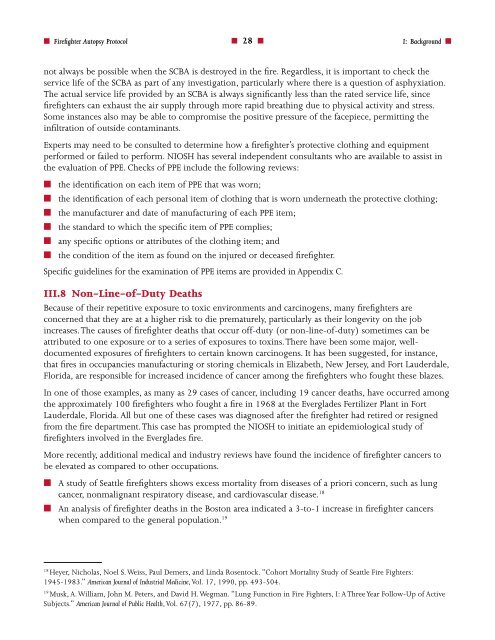Firefighter Autopsy Protocol - US Fire Administration - Federal ...
Firefighter Autopsy Protocol - US Fire Administration - Federal ...
Firefighter Autopsy Protocol - US Fire Administration - Federal ...
You also want an ePaper? Increase the reach of your titles
YUMPU automatically turns print PDFs into web optimized ePapers that Google loves.
■ <strong><strong>Fire</strong>fighter</strong> <strong>Autopsy</strong> <strong>Protocol</strong><br />
■ 28 ■<br />
I: Background ■<br />
not always be possible when the SCBA is destroyed in the fire. Regardless, it is important to check the<br />
service life of the SCBA as part of any investigation, particularly where there is a question of asphyxiation.<br />
The actual service life provided by an SCBA is always significantly less than the rated service life, since<br />
firefighters can exhaust the air supply through more rapid breathing due to physical activity and stress.<br />
Some instances also may be able to compromise the positive pressure of the facepiece, permitting the<br />
infiltration of outside contaminants.<br />
Experts may need to be consulted to determine how a firefighter’s protective clothing and equipment<br />
performed or failed to perform. NIOSH has several independent consultants who are available to assist in<br />
the evaluation of PPE. Checks of PPE include the following reviews:<br />
■ the identification on each item of PPE that was worn;<br />
■ the identification of each personal item of clothing that is worn underneath the protective clothing;<br />
■ the manufacturer and date of manufacturing of each PPE item;<br />
■ the standard to which the specific item of PPE complies;<br />
■ any specific options or attributes of the clothing item; and<br />
■ the condition of the item as found on the injured or deceased firefighter.<br />
Specific guidelines for the examination of PPE items are provided in Appendix C.<br />
III.8 Non-Line-of-Duty Deaths<br />
Because of their repetitive exposure to toxic environments and carcinogens, many firefighters are<br />
concerned that they are at a higher risk to die prematurely, particularly as their longevity on the job<br />
increases. The causes of firefighter deaths that occur off-duty (or non-line-of-duty) sometimes can be<br />
attributed to one exposure or to a series of exposures to toxins. There have been some major, welldocumented<br />
exposures of firefighters to certain known carcinogens. It has been suggested, for instance,<br />
that fires in occupancies manufacturing or storing chemicals in Elizabeth, New Jersey, and Fort Lauderdale,<br />
Florida, are responsible for increased incidence of cancer among the firefighters who fought these blazes.<br />
In one of those examples, as many as 29 cases of cancer, including 19 cancer deaths, have occurred among<br />
the approximately 100 firefighters who fought a fire in 1968 at the Everglades Fertilizer Plant in Fort<br />
Lauderdale, Florida. All but one of these cases was diagnosed after the firefighter had retired or resigned<br />
from the fire department. This case has prompted the NIOSH to initiate an epidemiological study of<br />
firefighters involved in the Everglades fire.<br />
More recently, additional medical and industry reviews have found the incidence of firefighter cancers to<br />
be elevated as compared to other occupations.<br />
■ A study of Seattle firefighters shows excess mortality from diseases of a priori concern, such as lung<br />
cancer, nonmalignant respiratory disease, and cardiovascular disease. 18<br />
■ An analysis of firefighter deaths in the Boston area indicated a 3-to-1 increase in firefighter cancers<br />
when compared to the general population. 19<br />
18<br />
Heyer, Nicholas, Noel S. Weiss, Paul Demers, and Linda Rosentock. “Cohort Mortality Study of Seattle <strong>Fire</strong> Fighters:<br />
1945-1983.” American Journal of Industrial Medicine, Vol. 17, 1990, pp. 493-504.<br />
19<br />
Musk, A. William, John M. Peters, and David H. Wegman. “Lung Function in <strong>Fire</strong> Fighters, I: A Three Year Follow-Up of Active<br />
Subjects.” American Journal of Public Health, Vol. 67(7), 1977, pp. 86-89.
















